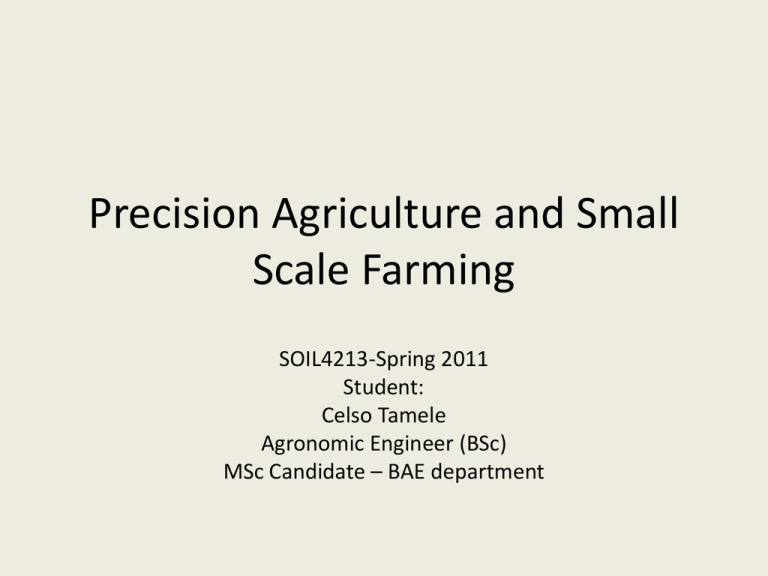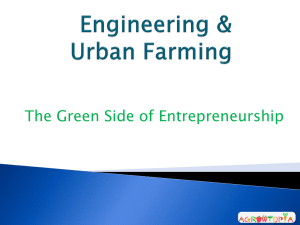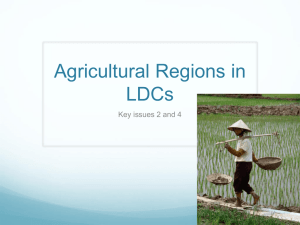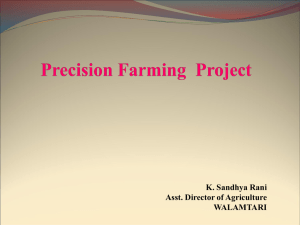Precision Agriculture and Small Scale Farming
advertisement

Precision Agriculture and Small Scale Farming SOIL4213-Spring 2011 Student: Celso Tamele Agronomic Engineer (BSc) MSc Candidate – BAE department Objectives • Assess small scale farming in the sub-Saharan Africa context. • Assess the suitability of current precision agriculture techniques for small scale agriculture. • Identify precision agriculture technologies that are suitable for small scale agriculture. Background • Different definitions for small scale farming: – Small-scale agriculture is an alternative to factory farming or more broadly, intensive agriculture or unsustainable farming methods that are prevalent in primarily first world countries (www.wikipedia.com). – Some individuals feel a small farm is any farm below the industry average. Others like to base their definition on how many acres or hectares you have. In general, a small farm is any farm that requires an off-farm income to provide the farmer with a decent way of life. (http://www.suite101.com/article.cfm/farming/15541). – USDA definition: "small farms" are farms with less than $100,000 in value of annual production and "non-commercial" farms sell less than $50,000 per year (http://web.missouri.edu). Background • “Most of the population in developing countries is still engaged in traditional farming with limited application of modern technologies in rural areas. The key restriction is obviously due to the backwardness of agricultural sciences and technology, and limited input to agriculture” (Maohua, 2001) . Source: http://www.solutions-site.org Small scale farming in Sub-saharan Africa www.nric.net Small scale farming in Sub-saharan Africa • Source: Spencer (2001) • Over 96% of the farmers are small. • Small farms account for over 90% of agricultural production. • Cultivated areas of less than 5ha (large group with <1ha). • Example: Zimbabwe 2001 – Large scale farms (>80ha) yielding 5-6 ton maize (2001 data). Account for less than half total maize production. – 99% of farmers are small scale, yielding 1.5ton/ha. • Majority of small scale farms have weak linkages to markets and little or no access to external inputs. Precision Ag. Technologies for Small Scale Farming • Problem= poverty of knowledge + small scale farms+low inputs Corn average yield developing countries1 (ton/ha) Corn average yield USA2 (ton/ha) Corn price2 Gross ($/ton) profit for a 2ha farm with current yields($) Gross profit for a 2ha farm with potential yields($) 125hp (used) tractor price($) 1.5 9.2 $160/ton ($4/bu) 2944 55500 480 1-http://old.iita.org/; 2-www.nue.okstate.edu/ *1 bu/ac=0.06ton/ha; 1bu(corn)=25kg=0.025ton; 1ac=0.4ha Q: Are current precision Ag. technologies feasible? A: At this scale, yields and trade scenario they are not. “Small is beautiful, but it’s small” – Richard Critchfield, 1977. Small scale farming in Sub-Saharan Africa Challenges for small scale farmers: • Decline of prices for traditional commodities (cocoa, cotton, oil palm etc). • Increasing costs of inputs at farm level. • Globalization phenomenon where world trade agreements resulted in loss of urban markets of major cities to imported goods. • This trend is leading to poverty and migrations (to the cities and to the West and East). Small scale farming in Sub-saharan Africa • Profitability is a big issue. World trade scenario and the need for mass production often hinders small scale farming. Source: http://newworldnotes.blogspot.com Small scale farming in Sub-Saharan Africa Solutions to change the scenario include: • Take small farmers into account in national and international policymaking. • Invest in rural infrastructure and invest in people-centered development. • Support research and extension systems. • Increase access to fertilizers and credit (critical inputs for adoption of more modern production practices). Small scale farming in Sub-Saharan Africa Simple technological inputs can increase yields. Farmer field using in-situ water harvesting technique. Source: IP Consult/PROGRC Precision Ag. Technologies for Small Scale Farming • Advanced technologies are prohibitive to most small scale farmers due to it’s cost. Therefore Appropriate Technologies are a common approach. • Appropriate technologies has several definitions: • “ The U.S Congress Office of Technology Assessment characterizes Appropriate Technology as being small scale, energy efficient, environmentally sound, labor-intensive, and controlled by the local community” (Hazeltine and Bull, 1999). • Appropriate technology (AT) is a technology that is designed with special consideration to the environmental, ethical, cultural, social, political, and economical aspects of the community it is intended for (www.wikipedia.com). Precision Ag. Technologies for Small Scale Farming “Small farmers have always employed precision agriculture because they knew every square meter of their farms and how production can vary from one square meter to another”- Maohua (2001). Technological choices (as described by Hazeltine and Bull,1999): • Crop selection: food or cash? – Variety adapted for the region. – Part of the yield is often used as seeds. www.savingourseeds.org Precision Ag. Technologies for Small Scale Farming • Tool selection: – Fertilizer application: reference strips, natural fertilizers (e.g manure, cover crops). – Pesticide application: natural pesticides (e.g Neem oil). Source:www.buzzle.com • Planting method: – Hand planter. – Tilling machine. • Reaping methods: – Human powered Harvester?? Source: www.nue.okstate.edu Source: www.fao.org Conclusions • Lack of knowledge and inputs are the main causes of reduced yield for small scale farming in sub-saharan Africa. • Small scale farming in sub-saharan Africa is hindered by the current world trade scenario and it is adequate only for local economies. • Precision agriculture can be applied for small scale farming depending on the technological package to be implemented. • Current precision agriculture technologies are often prohibitive for small scale farmers due to their cost. • Appropriate precision Ag. technologies can be used to help small farmers bridge to a more commercial agriculture with reduced environmental impacts. References Hazeltine, B. and Bull, C. (1999). Appropriate technology- Tools, Choices and Implications. Academic press.San Diego, USA. 363pp. Maohua, W. (2001). Possible adoption of precision agriculture for developing countries at the threshold of the new millennium. Computers and elctronics in Agriculture 30. 40-45 Spencer, D. (2001). Will they survive? Prospects for small farmers in Sub-Saharan Africa. Sustainable food security for all by 2020 seminar. IFPRI. Available at http://conferences.ifpri.org/. Accessed on 8 April 2011. Obrigado/ Thank you/Kanimambo








